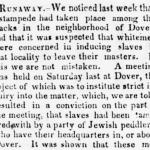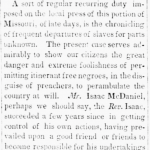Search Summary
- Search conducted by Cooper Wingert between March 5-7, 2019.
- Keywords: slave and stampede, including variant “negro stampede.” The term “stampeding” did not yield relevant results.
- Totals: 8 hits
Top Results
- In November 1849, the Palmyra Whig provided detailed coverage of the sizable “negro stampede” near Canton, Missouri, in neighboring Lewis County. Some 27 “men, women and children” armed themselves with “guns, knives and bludgeons” and made their way towards freedom. When they were discovered near Canton, “an effort was made to take them, which they resisted.” After a slave who “appeared to be the master-spirit of the party” was killed, “the rest were taken without much trouble.” However, the paper warned slaveholders and readers in general to “keep a vigilant watch on their servants.” (“Negro Stampede,” Palmyra Whig, November 8, 1849)
- A week later, the paper reported that “the leaders in the stampede have been shipped to St. Louis and sold.” (“The Lewis County Affair,” Palmyra Whig, November 15, 1849)
- In February 1854, the paper published the proceedings of a public meeting held in Fabius Township, Marion County, “that particular portion of the county which suffered in the recent stampede of negroes” in November 1853. The stampede cost the slave owners of Fabius “some $15,000,” the paper reported. “They have been wantonly, wickedly robbed of their property,” the column declared. (“Prompt Proceedings,” Palmyra Whig, February 23, 1854)
- In October 1854, the paper reprinted a column from the Lexington, Missouri Weekly Express, which reported that “a stampede had taken place among the blacks in the neighborhood of Dover, [Missouri], and that it was suspected that whitemen were concerned in inducing slaves in that locality to leave their masters.” Local slaveholders accused “a party of Jewish peddlers” of providing the slaves with money and “maps, with the roads to be traveled marked out.” Several of the escaped slaves were recaptured after having crossed to the north side of the Missouri river, and one fugitive “resisted, and was shot before taken, but it is not thought to endanger his life.” (Lexington, MO Weekly Express, quoted in “Runaway,” Palmyra Whig, October 5, 1854)
- In October 1856, under the heading “Another Stampede,” the Palmyra Whig complained about the “frequent departures of slaves for parts unknown.” Reporting on group escapes had become “a sort of regular recurring duty imposed on the local press of this portion of Missouri.” The most recent “stampede” involved a free African-American named Isaac McDaniel, who “stole not only his wife, but some four or five other slaves in the neighborhood” of Hannibal, Missouri. McDaniel’s party also “stole a horse and buggy belonging to his wife’s master,” to effect their escape. (“Another Stampede,” Palmyra Whig, October 23, 1856)
- Quoting the Lexington, Kentucky Atlas, the Palmyra Whig carried a column about a “stampede” of “between forty and seventy negroes” from Kentucky. The incident ended after a violent clash and the recapture of many of the freedom seekers, along with a white college student who had assisted in their escape. (Lexington, KY Atlas, quoted in Palmyra Whig, August 24, 1848)
- In May 1851, the paper reprinted a column from the Maysville, Kentucky Post-Boy, which noted that “during the past week a leave-taking fever has prevailed among the slaves in this section. On Sunday night a woman and three children, the property of Miss Weeden of our city, left. On Wednesday night, nineteen in one gang, left their owners in Lewis… From Nicholas several have also left within a few days.” (Maysville, KY Post-Boy, quoted in, “Negro Stampede,” Palmyra Whig, May 5, 1851)
Select Images
- Palmyra Whig, February 23, 1854
- Palmyra Whig, October 5, 1854
- Palmyra Whig October 23, 1856
General Notes
- The Palmyra Whig is available to the public through the State Historical Society of Missouri’s digital newspapers collection.
- Coverage is missing from late 1853, when a major stampede on our timeline occurred from Marion County.




